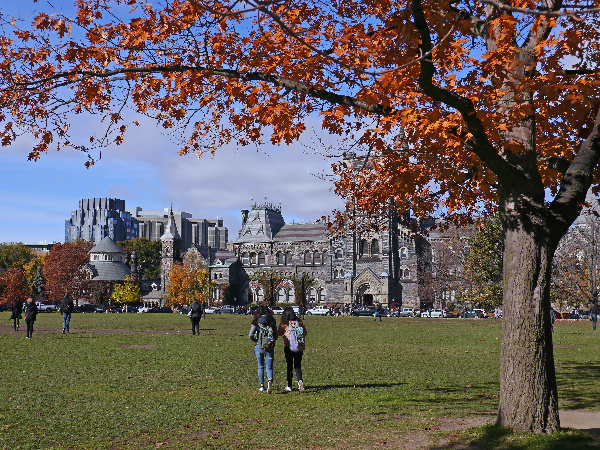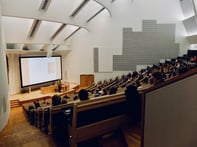Published on
Student-Centric: Buzzword or Blueprint?

Being a truly student-centric higher education institution goes beyond simply making students the focus of operations. It requires seeing the world from the student’s point of view, and adapting and personalizing offerings to meet what they need.
As president of University of Maryland Global Campus (UMGC), I am often asked what it means to be student-centric. Unfortunately, buzzwords are rampant, and higher education is not immune. So, while the terms student-centric and student-centricity are in common use, they too often receive little more than lip service. So, what is student-centricity?
Now, this might be a bit controversial, but I don’t believe that every higher education institution is student-centric, nor must it be—at least not in the way I discuss it here. If students are central to everything you do—your raison d’être—it will manifest itself in one of two ways. For most institutions, it will mean that every resource focuses on the learner, and everyone is looking in. In truth, this is the simpler of the two approaches, because the student becomes almost specimen-like, with everyone studying and observing them.
The more challenging version of student-centricity requires designing or redesigning an institution after first positioning yourself to see the world from the learner’s point of view, looking out. This is an approach landscape architects increasingly use when designing public spaces. When creating a park, for instance, they carve out paths after first observing where people tend to walk, not where the architect thinks they should walk.
It may seem overly nuanced, but there is a significant difference between crafting communications, policies or structures as an expert, even an expert who holds the student in mind, and seeing the experience through the student’s eyes and adjusting to it. And frankly, in recognizing that there are many different jobs to do, not every institution will embrace this approach as priority no. 1.
I don’t mean to suggest that there are institutions that don’t see students as very important, but colleges and universities serve many different functions. A top-tier research institution, for example, will certainly have students and a great learning environment, but some also have reward systems, compensation structures and teaching loads that reflect other priorities. The contributions these institutions make are commendable and valuable, but if the institutional culture positions fewer student interactions as a perk, is it realistic to categorize the institution as student-centric?
At UMGC, I encourage team members to constantly ask, “Are we seeing the learning experience from the student’s vantage point?” When we send a communication or response, it is not enough that it is accurate; it must also effectively relay our values, not just the words on the page. We strive every day, often in ways that can be hard to explain, to get better at being student-centric in both contexts I have discussed here: carefully attending to our learners and their circumstances by focusing in, while building learning experiences that demonstrate that we are aware of the world as they see it, looking out.
This work has been important throughout our history. The student studying in Antarctica, in an active battle zone, in the desert or jungle, the learner in the Mediterranean preparing for an exam while coping with their spouse’s ready-to-deploy orders, the high school student in Japan whose parent has left on a mission for an undefined period of time—how do we ensure every interaction considers the world through their eyes?
With that question in mind, we regularly and proactively gather learner feedback, seeking to understand what learning experiences will help them thrive professionally, what tools and strategies will help them on their academic journeys and what forms of support best align with the obstacles they face.
Embracing a Student-Centric Worldview
UMGC was purpose-built to respond to the needs of adult learners in the workforce and the military. That focus on student needs and expectations has guided our university for over 75 years, shaping every facet of our operations online and at more than 175 locations around the globe. We strive to create an environment wherein our team members can meet students where they are, removing barriers and creating pathways to success for individuals who may previously have experienced education as little more than a series of obstacles and failures.
We seek to instill a student-centric mindset by considering the whole learner, including their academic, financial and personal goals and challenges. We charge our faculty—whether they are designing a learning experience, credentialing an experience or teaching a class—to refrain from letting ego or their preferred way of engaging cause them to miss new ways of assessing learning or seeing new opportunities for students to progress. We assign our learners a success coach who partners with them from the moment they enroll and is instrumental in guiding them as they move forward, keeping them on track by developing learning strategies, clarifying their education and career goals, assisting them with course selection and establishing a pace tailored to their abilities and desired outcomes.
At the same time, we use technology and analytics to get progressively better at anticipating and responding to student needs, developing better insights into where and why they struggle and responding in real time with the support and resources they need to maintain momentum and ultimately succeed. We are objective in accepting transfer credits from other institutions and award credit for learning acquired on the job, in military training, etc. We strive to foster a servant leadership approach, so our team members feel supported and equipped with the right resources, while accepting the reality that we will likely never be higher than our learners’ third priority, after family and career.
We award grants and scholarships to tens of thousands of learners each year, often prioritizing those who face extenuating circumstances. For example, we established the Student Aid Fund for Emergency Relief (SAFER) to grant modest, just-in-time awards—typically $500 each—to learners facing challenging circumstances stemming from the COVID-19 pandemic. These awards can go toward covering expenses such as housing, food and childcare, and student response has been overwhelming and sometimes heartbreaking. One recipient wrote, “As a single mother with two children, I have very little room in my budget for things outside of the bare necessities… Thank you for your generosity and compassion.”
Again, our team members provide the personal touch that aligns our operations with the realities of individual learners. When one current UMGC student began to apply for a Pillars of Strength scholarship—earmarked for the caregivers of wounded, injured or ill veterans—she abandoned her application, thinking that she wasn’t worthy of the support because her husband’s disabilities are invisible and appeared not as “bad” as some of the devastating injuries others have sustained. Fortunately, a UMGC team member was paying attention and reached out, encouraging her to complete the application.
Recently, that student wrote, “This scholarship gives me and my family peace of mind, especially financially. It’s amazing—I have a zero balance for the rest of the school year. It also means I can successfully finish my second master’s degree.”
The Student-Centric Worldview as Catalyst for Change
Higher education as a whole and adult higher education in particular are in a state that the military refers to as VUCA: volatile, uncertain, complex and ambiguous. For those who have been paying attention, this comes as no surprise. Historically, enrolling in higher education has been like purchasing a mystery box or a grab bag: You weren’t sure what you would get, and you could only hope it was worth the cost. And yet students were told repeatedly and convincingly that they needed to attend college and that their long-term success was contingent on earning a degree.
Unfortunately, few were as conscientious about ensuring the courses and programs truly met student needs or that learning experiences were structured to deliver what they promised: the knowledge, skills and abilities that are the common currency of today’s workforce. All too often those in higher education assumed that, if we built it, they would come. Or, to use another figure of speech, students would eat what we put on the table without questioning whether it was truly nourishing. As a result, many are now publicly skeptical of the value of a college degree, even as demographics shift and more learners come to the classroom later in life and from different cultural, economic and academic backgrounds. Prospective students are becoming increasingly discriminating as consumers, less likely to purchase on reputation alone and less willing to settle for prepackaged solutions.
As institutions struggle to navigate this uncharted terrain, a truly student-centric worldview can be one path to success. Rather than building cultures that attempt to pigeonhole students or convince them to buy what the institution already offers, we can embrace the opportunity to learn to see the world as our students see it, to respond to their needs and viewpoints rather than to what tradition tells us is the right solution. This approach, I believe, can form the blueprint for the 21st-century university, one that is truly equipped to inspire hope, empower dreams and transform lives one student at a time.



